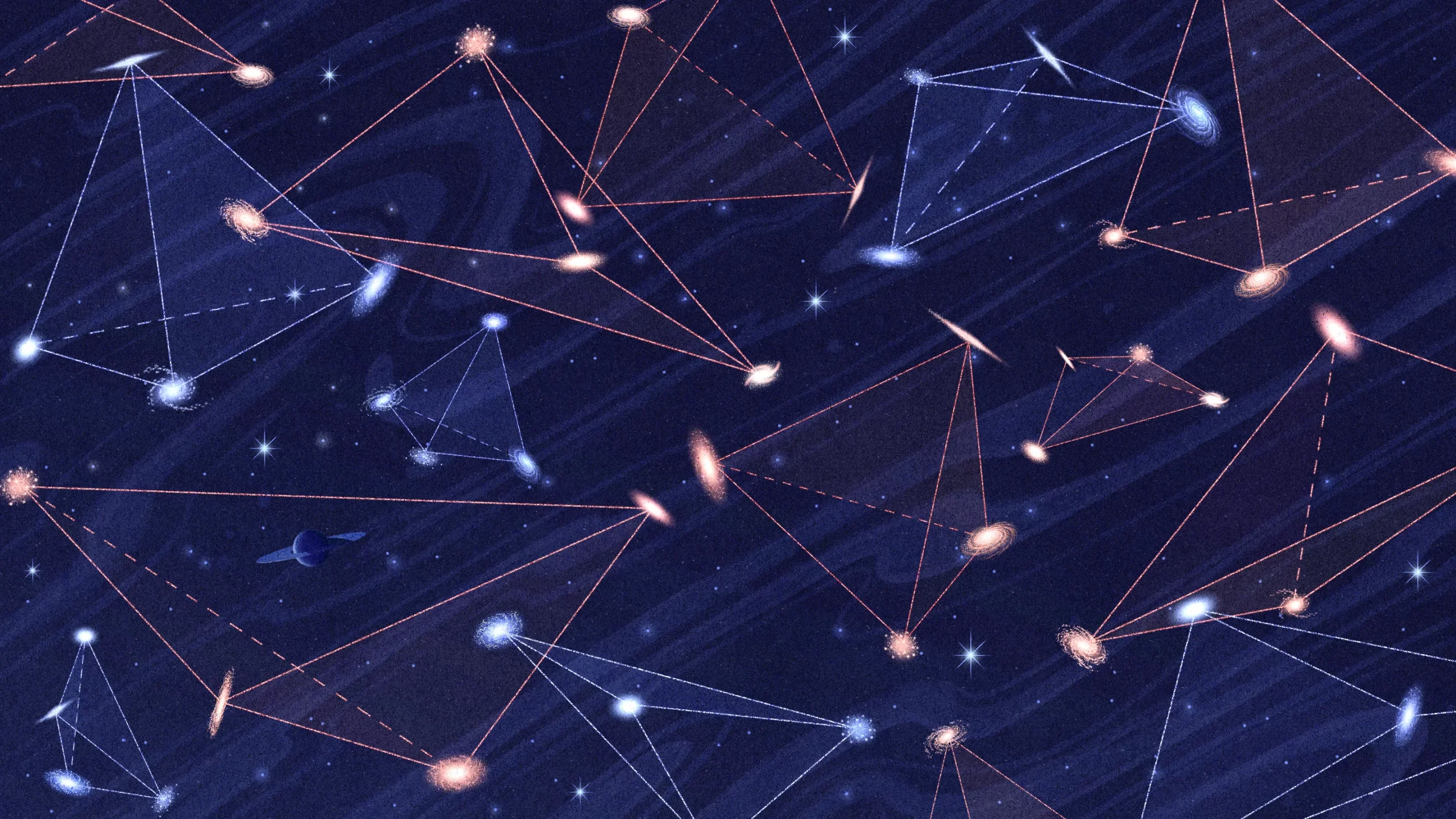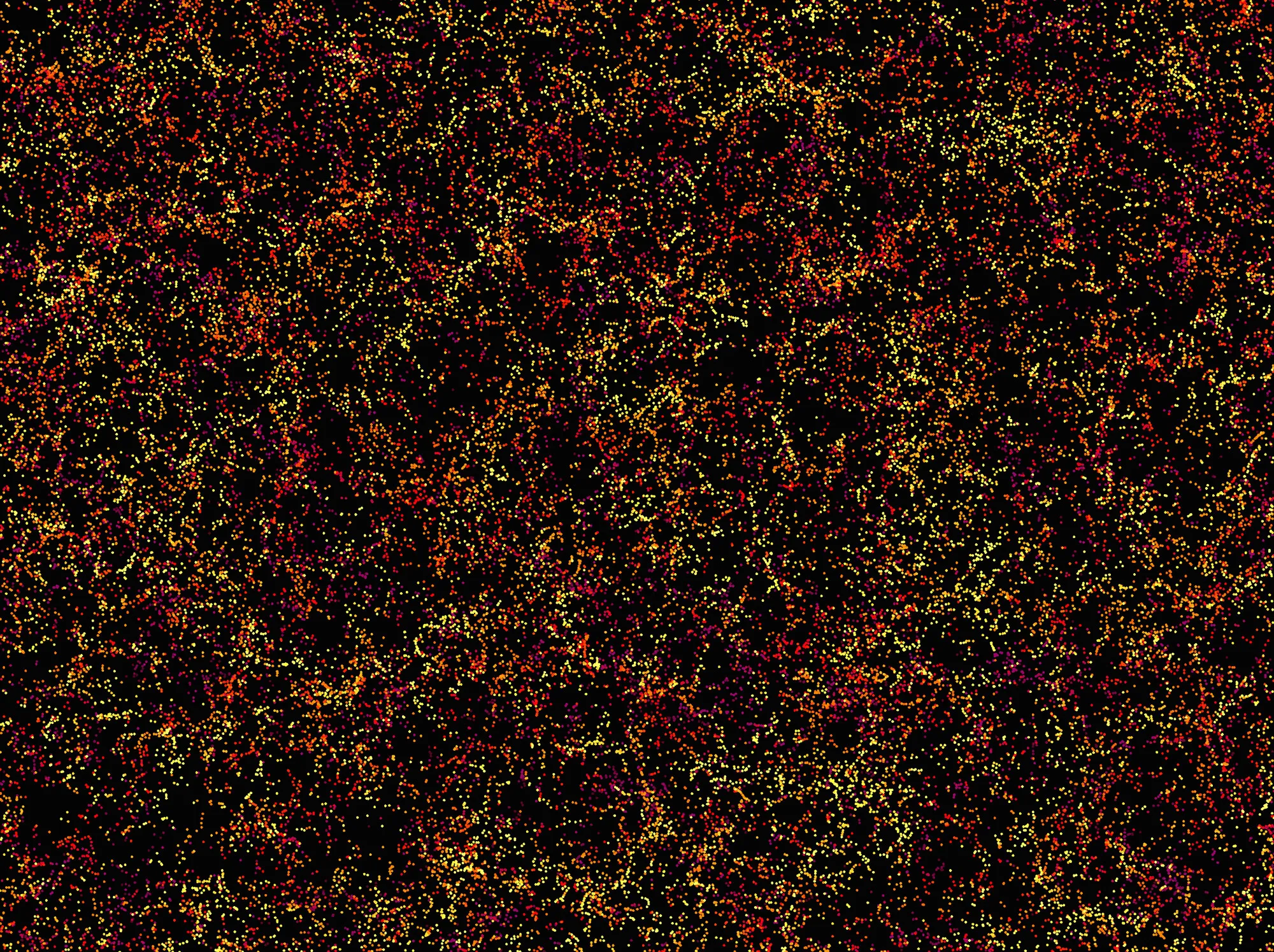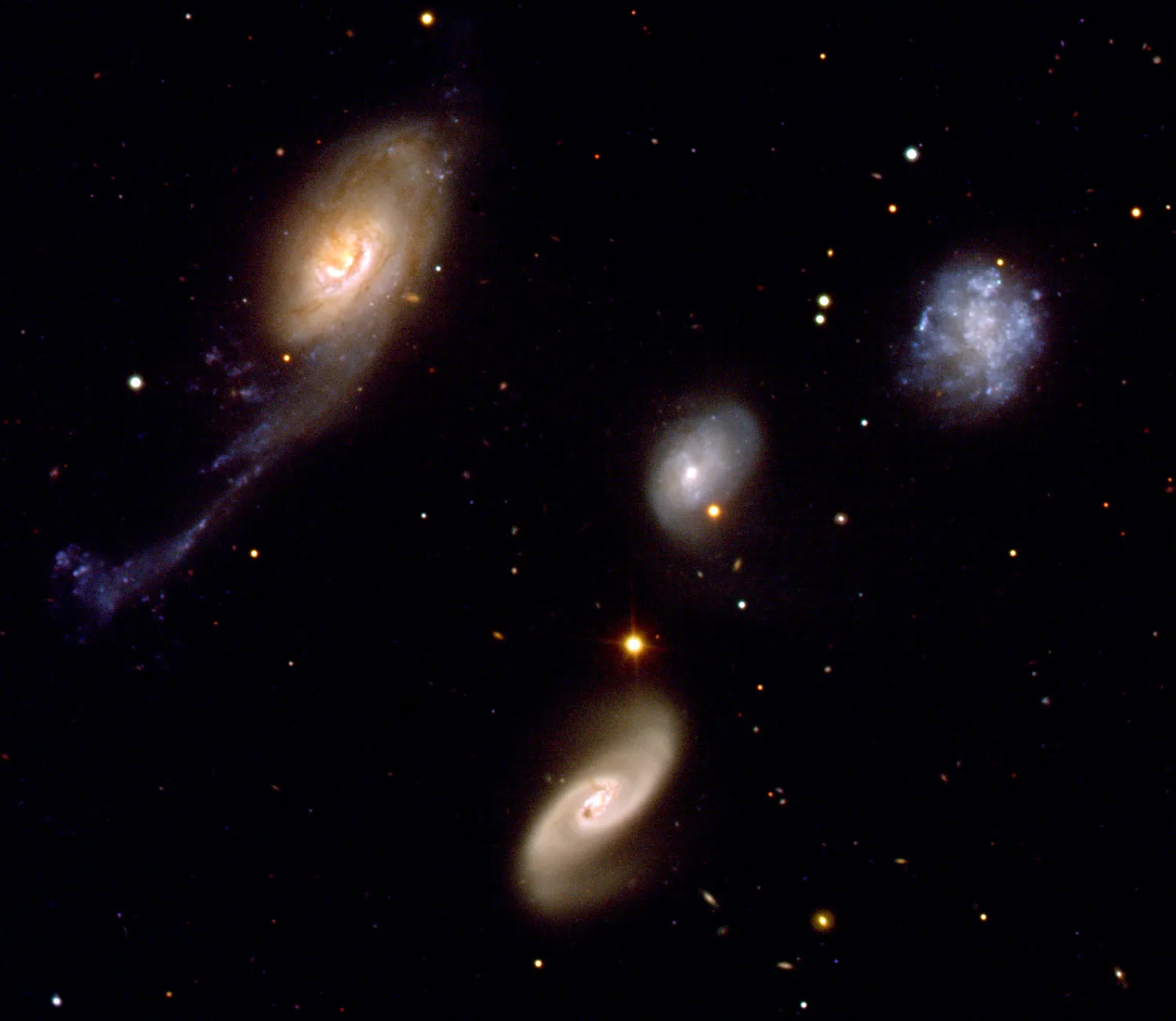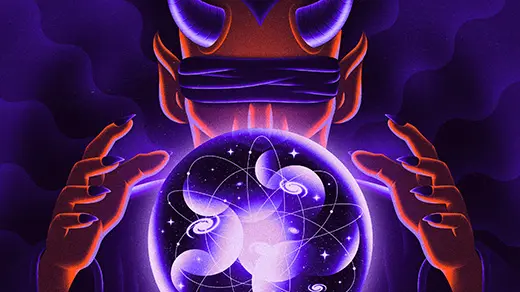Asymmetry Detected in the Distribution of Galaxies

When researchers counted tetrahedra whose side-lengths increase in the clockwise and counterclockwise directions, they found a surprising imbalance.
Myriam Wares for Quanta Magazine
Introduction
Physicists believe they have detected a striking asymmetry in the arrangements of galaxies in the sky. If confirmed, the finding would point to features of the unknown fundamental laws that operated during the Big Bang.
“If this result is real, someone’s going to get a Nobel Prize,” said Marc Kamionkowski, a physicist at Johns Hopkins University who was not involved in the analysis.
As if playing a cosmic game of Connect the Dots, the researchers drew lines between sets of four galaxies, constructing four-cornered shapes called tetrahedra. When they had built every possible tetrahedron from a catalog of 1 million galaxies, they found that tetrahedra oriented one way outnumber their mirror images.
A hint of the imbalance between tetrahedra and their mirror images was reported by Oliver Philcox, an astrophysicist at Columbia University in New York, in a paper published in Physical Review D in September. In an independent analysis conducted simultaneously that’s now undergoing peer review, Jiamin Hou and Zachary Slepian of the University of Florida and Robert Cahn of Lawrence Berkeley National Laboratory detected the asymmetry with a level of statistical certainty that physicists usually consider definitive.
But with such a blockbuster finding — and one that’s still under review — experts say caution is warranted.
“There’s no obvious reason that they’ve made a mistake,” said Shaun Hotchkiss, a cosmologist at the University of Auckland. “That doesn’t mean that there isn’t a mistake.”
The putative imbalance violates a symmetry called “parity,” an equivalence of left and right. If the observation withstands scrutiny, physicists think it must reflect an unknown, parity-violating ingredient in the primordial process that sowed the seeds of all the structure that developed in our universe.
“It’s an incredible result — really impressive,” Kamionkowski said. “Do I believe it? I’m going to wait to really celebrate.”
Left-Handed Universe
Parity was once a cherished symmetry of physics. But then, in 1957, the Chinese American physicist Chien-Shiung Wu’s nuclear decay experiments revealed that our universe indeed has a slight handedness to it: Subatomic particles involved in the weak nuclear force, which causes nuclear decay, are always magnetically oriented in the opposite direction from the one they move in, so that they spiral like the threads of a left-handed screw. The mirror-image particles — the ones like right-handed screws — don’t feel the weak force.
Wu’s revelation was shocking. “We are all rather shaken by the death of our well-beloved friend, parity,” the physicist John Blatt wrote in a letter to Wolfgang Pauli.
The left-handedness of the weak force has subtle effects that couldn’t have influenced the cosmos on galactic scales. But ever since Wu’s discovery, physicists have sought other ways in which the universe differs from its mirror image.
If, for instance, some primordial parity violation was in effect when the universe was in its infancy, it might have imprinted a twist onto the structure of the cosmos.
At or near the time of the universe’s birth, a field known as the inflaton is thought to have permeated space. A roiling, boiling medium where inflaton particles continuously bubbled up and disappeared, the inflaton field was also repulsive; for the brief time it may have existed, it would have caused our universe to rapidly expand to 100 trillion trillion times its original size. All of those quantum fluctuations of particles in the inflaton field were flung outward and frozen into the cosmos, becoming variations in the density of matter. The denser pockets continued to gravitationally coalesce to produce the galaxies and large-scale structure we see today.
In 1999, researchers including Kamionkowski considered what would happen if more than one field was present before this explosion. The inflaton field could have interacted with another field that could produce right-handed and left-handed particles. If the inflaton treated right-handed particles differently than the left-handed ones, then it could have preferentially created particles of one handedness over the other. This so-called Chern-Simons coupling would have imbued the early quantum fluctuations with a preferred handedness, which would have evolved into an imbalance of left-handed and right-handed tetrahedral arrangements of galaxies.
As for what the additional field might be, one possibility is the gravitational field. In this scenario, a parity-violating Chern-Simons interaction would occur between inflaton particles and gravitons — the quantum units of gravity — which would have popped up in the gravitational field during inflation. Such an interaction would have created a handedness in the density variations of the early universe and, consequently, in today’s large-scale structure.

Each dot in this picture, which covers about one-twentieth of the sky, represents the location of a galaxy mapped by the Sloan Digital Sky Survey and its Baryon Oscillation Spectroscopic Survey. A statistical analysis of 1 million galaxies in the survey has found evidence of parity violation.
Daniel Eisenstein/SDSS-III collaboration
In 2006, Stephon Alexander, a physicist now at Brown University, suggested that Chern-Simons gravity could also potentially solve one of the biggest mysteries in cosmology: why our universe contains more matter than antimatter. He surmised that the Chern-Simons interaction could have yielded a relative abundance of left-handed gravitons, which would in turn preferentially create left-handed matter over right-handed antimatter.
Alexander’s idea remained relatively obscure for years. When he heard about the new findings, he said, “that was a big surprise.”
Tetrahedra in the Sky
Cahn thought the possibility of solving the matter-antimatter asymmetry puzzle with parity violation in the early universe was “speculative, but also provocative.” In 2019, he decided to look for parity violation in a catalog of galaxies in the Sloan Digital Sky Survey. He didn’t expect to find anything but thought it would be worth a check.
To test whether the galaxy distribution respects or violates parity, he and his collaborators knew they needed to study tetrahedral arrangements of four galaxies. This is because the tetrahedron is the simplest three-dimensional shape, and only 3D objects have a chance at violating parity. To understand this, consider your hands. Because hands are 3D, there’s no way to rotate a left one to make it look like a right one. Flip your left hand over so that the thumbs of both hands are on the left, and your hands still look different — the palms face opposite ways. By contrast, if you trace a left hand on a sheet of paper and cut out the 2D image, flipping the cutout over makes it look like a right hand. The cutout and its mirror image are indistinguishable.
In 2020, Slepian and Cahn came up with a way of defining the “handedness” of a tetrahedral arrangement of galaxies in order to compare the number of left-handed and right-handed ones in the sky. First they took a galaxy and looked at the distances to three other galaxies. If the distances increased in the clockwise direction like a right-handed screw, they called the tetrahedron right-handed. If the distances increased going counterclockwise, it was left-handed.
The tetrahedron is the simplest shape that has parity, or handedness. It looks different when reflected in a mirror.
Merrill Sherman/Quanta Magazine
To determine whether the universe as a whole has a preferred handedness, they had to repeat the analysis for all tetrahedra constructed from their database of 1 million galaxies. There are nearly 1 trillion trillion such tetrahedra — an intractable list to handle one at a time. But a factoring trick developed in earlier work on a different problem allowed the researchers to look at the parity of tetrahedra more holistically: Rather than assembling one tetrahedron at a time and determining its parity, they could take each galaxy in turn and group all other galaxies according to their distances from that galaxy, creating layers like the layers of an onion. By expressing the relative positions of galaxies in each layer in terms of mathematical functions of angles called spherical harmonics, they could systematically combine sets of three layers to make collective tetrahedra.
The researchers then compared the results to their expectations based on parity-preserving laws of physics. Hou led this step, analyzing fake catalogs of galaxies that had been generated by simulating the evolution of the universe starting from tiny, parity-preserving density variations. From these mock catalogs, Hou and her colleagues could determine how the tally of left- and right-handed tetrahedra randomly varies, even in a mirror-symmetric world.
The team found a “seven-sigma” level of parity violation in the real data, meaning that the imbalance between left- and right-handed tetrahedra was seven times as large as could be expected from random chance and other conceivable sources of error.
Kamionkowski called it “incredible that they were able to do that,” adding that “technically, it’s absolutely astounding. It’s a really, really, really complicated analysis.”
Philcox used similar methods (and had co-authored some earlier papers proposing such an analysis with Hou, Slepian and Cahn), but he made some different choices — for example, grouping the galaxies into fewer layers than Hou and colleagues, and omitting some problematic tetrahedra from the analysis — and therefore found a more modest 2.9-sigma violation of parity. The researchers are now studying the differences between their analyses. Even after extensive efforts to understand the data, all parties remain cautious.
Corroborating Evidence
The surprising finding hints at new physics that could potentially answer long-standing questions about the universe. But the work has only just begun.
First physicists need to verify (or falsify) the observation. New, ambitious galaxy surveys on which to repeat the analysis are already underway. The ongoing Dark Energy Spectroscopic Instrument survey, for instance, has logged 14 million galaxies so far and will contain more than 30 million when it’s completed. “That’ll give us an opportunity to look at this in much greater detail with much better statistics,” said Cahn.

A tetrahedral arrangement of galaxies known as Robert’s Quartet.
ESO
Moreover, if the parity-violating signal is real, it could show up in data other than the distribution of galaxies. The oldest light in the sky, for example — a bath of radiation known as the cosmic microwave background, left over from the early universe — provides our earliest snapshot of spatial variations in the cosmos. The dappled pattern of this light should contain the same parity-violating correlations as the galaxies that formed later. Physicists say it should be possible to find such a signal in the light.
Another place to look will be the pattern of gravitational waves that may have been generated during inflation, called the stochastic gravitational wave background. These corkscrew-like ripples in the space-time fabric can be right-handed or left-handed, and in a parity-preserving world, they would contain equal amounts of each. So if physicists manage to measure this background and find that one handedness is favored, this would be an unambiguous, independent check of parity-violating physics in the early universe.
As the search for corroborating evidence begins, theorists will study models of inflation that could have produced the signal. With Giovanni Cabass, a theoretical physicist at the Institute for Advanced Study in Princeton, New Jersey, Philcox recently used his measurement to test a slew of parity-violating models of inflation, including those of the Chern-Simons type. (They can’t yet say with certainty which model, if any, is correct.)
Alexander has also refocused his efforts on understanding Chern-Simons gravity. With collaborators including Kamionkowski and Cyril Creque-Sarbinowski of the Flatiron Institute’s Center for Computational Astrophysics, Alexander has begun working out subtle details about how Chern-Simons gravity in the early universe would influence the distribution of today’s galaxies.
“I was kind of like the lone soldier pushing this stuff for a while,” he said. “It’s good to see people taking an interest.”
Editor’s Note: The Flatiron Institute is funded by the Simons Foundation, which also supports this editorially independent magazine. In addition, Oliver Philcox receives funding from the Simons Foundation.
Correction: January 5, 2023
The article originally incorrectly stated that Philcox reported a hint of the asymmetry “first.” While his paper was the first to be peer-reviewed and published in a journal, Jiamin Hou and coauthors posted their preprint one day earlier than Philcox’s.



